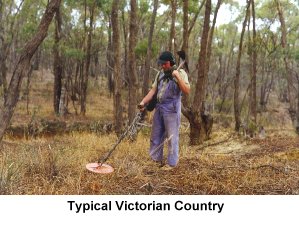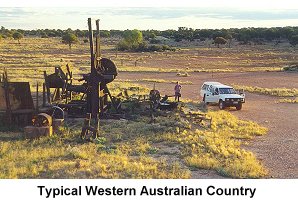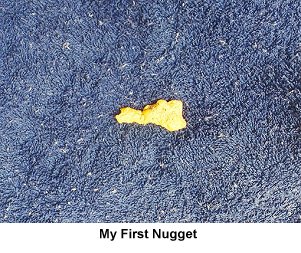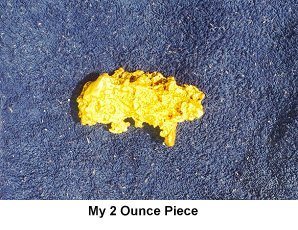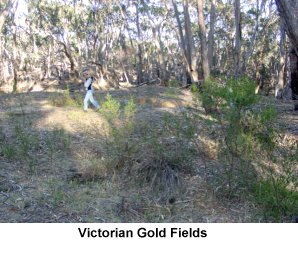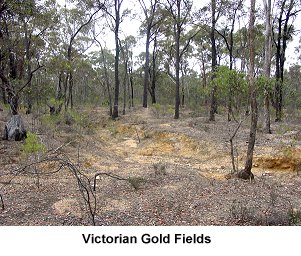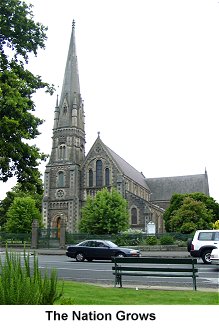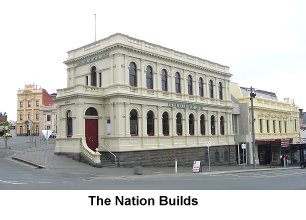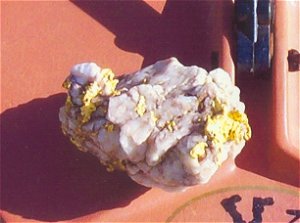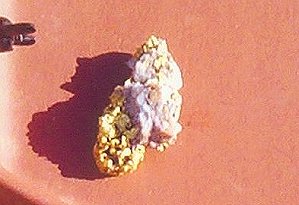
| July 2002 | ||||||||||||||||||||||||||||||||||||||||||
|
||||||||||||||||||||||||||||||||||||||||||
Contents
|
||||||||||||||||||||||||||||||||||||||||||
1. EDITORIAL Gold Net Australia is to undergo some substantial changes later this year. The entire concept of the site will alter - and the site will be constructed in such a way as to be more interactive with members and contributors. The magazine may alter substantially to bring the site into line with other online facilities and provide a more interactive site. Among the items planned are Forums and an on line Chat Site. The chat site is presently being tested and will soon appear.
Our Gold sales into the USA are increasing monthly. With our popularity as a quality site we are attracting a great deal of business including bullion sales.
We also advise that John Gladdis has retired from Coiltek - and is in the process of moving to Victoria.
No doubt we will see John from time to time - and we wish him well in his retirement. Perhaps we should say semi-retirement as I am sure John will be active in the Gold Fields for some time yet. This month we complete our story on the small township of Licola. It is a tragic story indeed, with government agencies running rampant and destroying peoples lives. It makes compelling reading. Editor Email: [email protected]
All material in this magazine is copyright and may not be reproduced in any part or form whatsoever without written permission from the publisher.
|
||||||||||||||||||||||||||||||||||||||||||
2. PURITY OF GOLD
 by Brad Williams Gold is a fascination to many who deal with it - in any form. But what it hides within those golden nuggets and pieces as they come from the ground is most interesting. But where is the best gold to be found in Australia? Now that is a question that is not easy to answer, although the purity of gold throughout Australia is quite high in the nuggets that come from recognised gold fields. One must speak in general terms as nuggets can vary so much even in the same gold field - but overall the gold that comes from the Victorian Gold Fields in the famed Golden Triangle is second to none anywhere in the world.
As one heads further west in Australia to the Golden West of Western Australia - the gold may be more prolific - but the purity is not generally of the same level as it is on the east coast.
To the naked eye, gold nuggets can look spectacularly bright - yet ironically this does not necessarily mean that the gold is of greater purity. Some quite dull nuggets actually contain more gold than some that are brighter.
Many say that the purest gold in Australia is found in North Queensland at the Palmer River Gold Field. Gold here is of a high quality but reflects generally the high concentrations that are found through-out the east coast.
Generally, nuggets from Australia are of high enough gold concentration to sell at gold price. In particular those nuggets that are in the 5 gram and above range, sell quite well, even if their gold concentration is as low as 90%. It really depends on what a nugget looks like - rather that the gold concentration. Gold that is often referred to as 'scrap' gold. That is gold nuggets that are under 3 grams and look 'scrappy', attract a price of gold less 5% when being traded to gold buyers - who after all need to consider their investment if they need to on sell to the Perth Mint for melting down. It should be said that smaller nuggets under 3 grams generally ends up being smelted at the Perth Mint, from all gold fields in Australia. Perth Mint will pay for the gold that is extracted, and in general in WA they are paying 10% below gold price - and from the eastern gold fields - around 5% below gold price. It simply depends on the amount of gold in the nugget.
Globally, Australian gold is well sought after and once a market is found sells well. It is just not that easy to find good markets for gold.
Of course there are always those who would want a bargain - with leaders around a couple of months ago for US$100 million in gold bullion being sought.
|
||||||||||||||||||||||||||||||||||||||||||
|
||||||||||||||||||||||||||||||||||||||||||
3. JAGGING A PIECE by Laurelle Murphy
Have you ever jagged a piece of gold while out prospecting? Now I can still remember the first little nugget I ever found. It was some years ago now - and I was a complete novice. I had become interested in gold since seeing a large nugget by chance that was shown in the local pub. It was about 22 ounces as I remember, and it was a beauty. I only had a few moments to glimpse this magnificent piece of gold - but it sure had an impact and from that day, I have always been interested in the treasure that lies in the ground.
I remember going home totally disillusioned with the whole 'detecting' thing. But that big nugget just kept my interest going, and eventually I went back again about 3 months later, and tried my luck down at Inglewood.
I was just about to break for lunch when I heard a signal that seemed somewhat faint, but thought I would dig it anyway. I had been told to dig everything, so I did. It took me a little while to find the sound in the dirt and rocks - but eventually there in my hand was a small piece of gold. It really was - yellow - and about 2 grams as it turned out - but to me it could have been the Welcome Stranger. I yelled and actually squealed with excitement, like a kid. I didn't stay there much longer after lunch. I just had to go home and show my folks the little piece that was to me a treasured possession. My parents didn't seem to be that impressed - but to me it was like winning the lottery. I glowed for days. Well, from that time on, I learnt to detect a little better, and eventually became quite adept at detecting pieces of gold. But without doubt I still remember that first little two grammer that began my quest with gold.
I must say - that it is not easy to always find gold. Patience is perhaps the most required element when detecting. Many days can be spent without as much as a hint of gold in the ground - although one would expect gold to be there, from the areas previous history. With the detectors that are presently available these days, gold can be found, and as technology progresses even more gold will be found.
I have never been lucky enough to find a large piece of gold. My biggest find was just 2.3 ounces at Dunolly about two years ago. I don't think I can ever say that when I have picked up a bit of gold - I have not had had a large grin from ear to ear. It is a great pleasure and one that I enjoy immensely, and will continue to enjoy for many years to come. See you out there - somewhere.
|
||||||||||||||||||||||||||||||||||||||||||
|
||||||||||||||||||||||||||||||||||||||||||
4. THE GOLD WITHIN VICTORIA by Craig Wilson
Victoria's mighty Gold Rush may be scheduled for a re-run.
A further 5,000 tonnes of the precious metal - twice what has already been dug up in the past 150 years - is thought by scientists to still lie hidden beneath the impassive landscape of the Murray River plains. "So far more than 2500 tonnes of gold has been unearthed in Victoria - 2 per cent of all the gold mined in human history - from sites along the hills. But we've just about run out of areas that can be easily prospected from the surface. However the geology gives us every reason to believe the gold continues under the Murray plain - and that two thirds of the prospective ground lies buried, sometimes hundreds of metres deep, under eroded surface rubble, soils and river flats."
The scientific team is preparing to follow a 500-kilometre 'slice' across the Victorian heartland from the SA border, through the Grampians, Bendigo, Benalla and Wodonga, curving down to Mallacoota on the coast. Using seismology, drill cores and aerial survey techniques, they will 'peel' away the surface layers to disclose an eerie, hidden landscape of undiscovered gold and mineral wealth, subterranean hills, valleys and fossil streams, extinct volcanoes and lurking environmental time bombs like salinity. The "Victorian Geotraverse" is the largest experiment of its kind in Australian history - a full-scale attempt to probe into the titanic processes that shaped today's Victoria and formed the wealth that has powered its economic and social prosperity for almost two centuries. It is also a vast test-bed for the technologies that will make the next generation of mineral discoveries across Australia, and pioneer the first generation of sophisticated environmental management and landscape-scale sustainable systems. Fifteen of the State's and nation's top earth science bodies plan to join hands with local and State government, industry and communities, to unlock hidden wealth, head off land degradation, create new regional jobs, industries and opportunities. The peak of gold production in Victoria spanned more than 60 years during the 19th century, with peak production in the mid-1850s, followed by a slow decline as gold from quartz veins replaced alluvial gold. Bendigo yielded 697 tonnes, Ballarat 408 tonnes and Castlemaine 173 tonnes. Nine other fields produced more than a million ounces (31t) of gold. Of this era of huge activity, only Stawell now remains a major producer, yielding about 100,000 ounces a year.
"Basically, huge plumes of liquid rock erupted from deep within the earth's crust and mantle as part of a major geological cataclysm that was taking place. These created super-hot waters deep down which, at 350 degrees, could dissolve many minerals including gold, and transport them to the surface."
Researchers believe that the original gold leads are still there, in "hills" buried many metres below the surface. The geotraverse project was discussed at a major conference, Victoria Undercover, that was held in Benalla from 30 April - 2 May, 2002.
|
||||||||||||||||||||||||||||||||||||||||||
|
||||||||||||||||||||||||||||||||||||||||||
|
5. WE ARE AUSTRALIA - PART 3  by Brad Williams Following the Great War to end all wars Australia moved forward in Nationhood. A united and committed young country was forging ahead into the 20th Century. What lay ahead after that great conflict could not have been foreseen and the trials and tribulations experienced were global calamities for the world. The years after the end of the Great War were difficult - unemployment was rife and of course the great depression of the 1929 - 1930 era had a serious impact on the economy. This was a global event that the developing western nations all experienced. The endless lines of unemployed and soup kitchens were not only seen in the US - but were similarly replicated in Australia. At this time the heart of the nation and its people were tested. The roads were frequented by "swagmen" humping their "bluey's". (Unemployed men roaming the bush, moving from farm to farm, town to town searching for work and for food, was a common sight at that time). These men would hump their belongings including a palliasse to sleep on at night. And of course they always carried a "billy". This was a metal can in which he would boil water and fill with tea leaves - and from which he would gain some freedom from his plight by drinking tea with his mates along the way.
Australia was still essentially a part of the British Empire. At this time the King of Australia was the British King, George the 6th. The call to arms to defend "home" as the UK was known at that time was again answered by the young men of this nation, in 1939 when The UK found itself again at war with Germany.
At the conclusion of this great conflict Australia had progressed. There were giant strides in technology and the economy after the war was booming. There were people from the Balkans, and from all over free Europe. These people and their cultures found a home and peace for their families and by the second generation assimilation into this peaceful and prosperous land was to them a way of life to be honoured and respected. In 1950 Australia again found itself at war, serving with the UN forces in Korea. Over 17,000 men and women served in this conflict against the Communist North Korean invasion of South Korea. More than 1500 casualties were suffered with 339 being killed.
Australia's commitment to the Vietnam war divided this nation - just as it divided the US. The conflict and civil disobedience within the nation with many demonstrations tore at the very fabric of democracy. Australia's commitment in Vietnam concluded with a change of federal government in the early 1970's. The democratic process was displayed for all to see. There was an era of stability during the 1970's. The nation was progressing positively with economic growth paralleling the best levels of prosperity of other western nations. Perhaps politically it could have been more stable - as the Governor General dismissed the elected Labor Government in 1975 - and the country went to a Federal election - where the Labor Government was swept from power - by the Liberal and National Party coalition. In Australia the Labor Party has similar policies to that of the Democrats in the US - where the Liberal National Parties - would be allied with the Republicans of the US. The political process in Australia is a true democracy. Voting in Australia is compulsory. At least if you are of voting age - you must register and on Election Day there is a legal requirement to attend at a polling booth and to have your name crossed off as having attended to vote.
Australia consists of a Federal Government which maintains control over matters - such as - Monetary control - Defence - Immigration - Taxation - Pensions - Customs - Imports and Exports. The third tier of government is Local Government. Known as Shire Councils - - District Councils or just Councils - this tier of government looks after local matters, like - local roads - rubbish collection - library resources - local parks and gardens.
What is referred to here - is a minimal look at Australian Government and the way it functions. As a result of a fine Constitution, this country enjoys perhaps the most peaceful country on earth. In the entire history of white settlement - there has only one recorded incident of organised rebellion in the history of this country. This occurred in the Gold fields of Victoria in 1954.
|
||||||||||||||||||||||||||||||||||||||||||
|
||||||||||||||||||||||||||||||||||||||||||
6. THE DEATH OF LICOLA - PART 4 by Ralph Barraclough TIP CLOSURE
The Licola tip was taken over by Parks Victoria. This was then closed, as Parks would not allow trees to be cleared for a new pit. The area bulldozed to stop access to the Caledonia Valley would have kept the land fill going on for between 400 to 500 years. LITTLE IMPROVEMENT Grass fuel, on areas burnt by the Caledonia fire of 1998, has built up to ridiculous and dangerous levels around sphagnum bogs, and ancient single trunk snow gums. The very environment Parks are supposed to be protecting is at serious risk. Parks have actively encouraged the fuel build-up again that caused the problems in the first place. Retired people from the timber industry have told the Licola community that there has been so much grass growing after the fire in the Carey State Park (surrounded by the National Park) that it has choked out large areas of regrowth woolly butt and wrecked a substantial area for timber production for the Heyfield saw mills for the next sixty years (cattle could not be put in there, as there was no boundary fence to stop them wandering into the National Park). Kevin Higgins and the other small land holders now face an even more dangerous situation after the fire with the uncontrolled grass build-up and dead trees around them in the park (Parks were well warned that this would happen). Kevin has been advised that it would he too dangerous for the Licola fire brigade to bring in a crew, or the fire truck, if there is a fire with a wind behind it, coming in from the Park. These people have done everything reasonably expected to protect their properties, they also fought the Caledonia fire to save many of their assets.
Minister Garbutt has said that the "Fire Protection Plan" balances the need for protection of life and property with the need to protect the natural features of the park. She was pleased to note the land holders in question had carried out everything reasonably expected of them.
Parks have not been able to list one thing they have learnt from the Caledonia fire, or any policy changes they have made to stop the same, or worse, from happening again. Old timers now consider the mountains to be at far more risk than before the devastating 1939 fires. On Kevin Higgins property, grazing has continued after the fire with no apparent erosion or damage to the numerous sphagnum bogs. Parks have claimed bog skinks are an endangered species in the park, yet these small lizards can he easily caught just through the fence on Kevin's land. CRAIG INGRAM Gippsland East independent, Craig Ingram, has said he will oppose legislation to create more National Parks, until the Government demonstrates it is serious about looking after those already established. He said there is ample evidence that the forests were open and park-like, not choked with undergrowth and weeds as they are today. THE GOVERNMENT
Our community is not opposed to national parks, it is just the management.
It should not be necessary for any small community like Licola to have to blockade or picket a National Park to try and stop environmental mismanagement that threatens the very existence of the environment it is supposed to protect.
Unfortunately the Liberals do not seem to be much better with their policies of supporting new parks that have a detrimental effect on small rural communities. During Easter 2001, over 600 people signed a letter to the Premier and independents with a sentence stating: "Many from the Licola community and visitors to the area, expect to be mislead, frustrated and lied to, when dealing with Parks Victoria." The Premier forwarded this to Minister Garbutt. There has been no further reply. It would have to be asked if this is now government policy? Judge Stretton made the comment in his report after the 1939 fires:- "to expose and scotch the foolish enmities which mar the management of the forests by public departments who being our servants, have become so much our masters that in some respects they loose sight Of our interests in the promotion of their mutual animosities." Editor: We support the stance of the residents of Licola.
|
||||||||||||||||||||||||||||||||||||||||||
|
||||||||||||||||||||||||||||||||||||||||||
7. FLECKS ! - Glints from here and there
|
||||||||||||||||||||||||||||||||||||||||||
|
|
||||||||||||||||||||||||||||||||||||||||||
|
||||||||||||||||||||||||||||||||||||||||||
8. STRIKES Recent Finds
|
||||||||||||||||||||||||||||||||||||||||||
|
||||||||||||||||||||||||||||||||||||||||||
|
9. THE NEW LODE - Next Month's Issue
|
||||||||||||||||||||||||||||||||||||||||||
|
||||||||||||||||||||||||||||||||||||||||||
